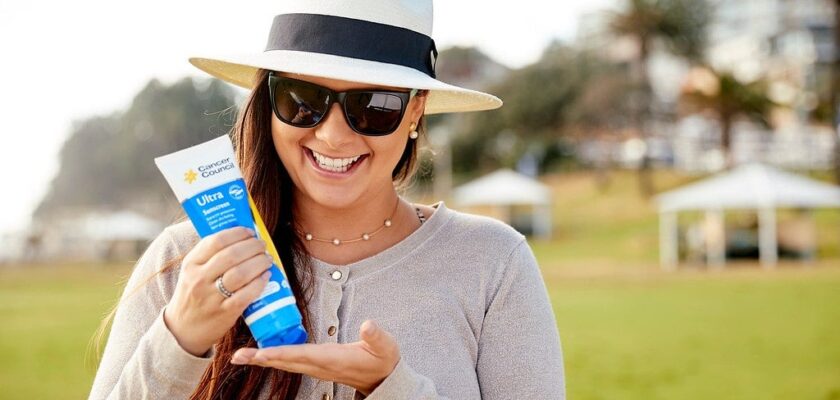The sun, with its radiant warmth and luminous rays, has been a source of vitality and joy for centuries. However, the same sun that gives life also poses potential risks to our skin. In the pursuit of relishing the outdoors without compromising our skin’s health, sunscreen emerges as a paramount companion. This unassuming lotion holds the power to shield us from the sun’s harmful ultraviolet (UV) rays, preventing sunburn, premature aging, and reducing the risk of skin cancer. As we embark on a journey to unravel the mysteries of sunscreen, this blog post will delve into the intricate mechanisms behind its protective prowess, demystify the concept of Sun Protection Factor (SPF), and address the intriguing question: Can we still attain a sun-kissed tan while donning this protective shield? Let’s explore the science, myths, and realities of sunscreen and unveil the secrets that lie beneath its seemingly simple application.
How does sunscreen work ?
How does sunscreen work? At its core, sunscreen operates as a formidable barrier against the sun’s potent ultraviolet (UV) rays, which come in two main varieties: UVA and UVB. These rays can wreak havoc on our skin, causing sunburn, premature aging, and increasing the risk of skin cancer. Sunscreen achieves its protective function through a sophisticated blend of organic and inorganic active ingredients. Organic, or chemical, filters absorb UV radiation and convert it into harmless heat, while inorganic, or physical, filters act as a reflective shield, bouncing UV rays away from the skin. This harmonious combination forms an invisible armor on the skin’s surface, serving as a formidable defense mechanism against the sun’s potentially harmful effects.
In practical terms, sunscreen intercepts the sun’s assault by either absorbing the energy of UV rays or reflecting them before they can penetrate the skin. By disrupting the harmful impact of UVA and UVB rays, sunscreen not only safeguards against painful sunburn but also plays a pivotal role in the long-term preservation of skin health. As we bask in the glow of the sun, understanding the intricate workings of sunscreen empowers us to enjoy the outdoors responsibly, striking a balance between embracing the warmth of sunlight and safeguarding our skin from its potential perils.
Understanding SPF:
Understanding SPF (Sun Protection Factor) is pivotal in navigating the world of sunscreen and making informed choices about sun exposure. SPF is a numerical indicator that gauges a sunscreen’s effectiveness in shielding the skin from UVB rays, the primary culprits behind sunburn. The SPF number represents the level of protection the sunscreen offers, indicating how much longer a person can stay in the sun without burning compared to if they weren’t wearing any protection. For instance, if your skin usually begins to burn after 10 minutes of sun exposure, applying an SPF 30 sunscreen theoretically extends that duration to 300 minutes (10 minutes multiplied by the SPF rating). However, it’s crucial to recognize that SPF does not create an impenetrable shield; instead, it provides a percentage of protection. An SPF 30 sunscreen blocks approximately 97% of UVB rays, while an SPF 50 blocks about 98%. The higher the SPF, the more incremental the increase in protection, emphasizing the importance of proper application and reapplication.
In choosing an appropriate SPF, it’s essential to consider factors such as skin type, location, and duration of sun exposure. While a higher SPF may offer slightly increased protection, regular reapplication and other sun-safe practices remain paramount. Moreover, SPF predominantly addresses UVB protection, and for comprehensive defense, it’s crucial to select a broad-spectrum sunscreen that also shields against UVA rays, responsible for premature aging. By understanding SPF as a tool for responsible sun care, individuals can make well-informed decisions to strike a balance between enjoying the sun and safeguarding their skin.
When and how do I put it on?
Knowing when and how to apply sunscreen is essential for maximizing its protective benefits. Sunscreen should be applied generously and evenly to all exposed skin at least 15 minutes before sun exposure. This allows the product to fully absorb and create a protective barrier. Be thorough in your application, covering often overlooked areas like the ears, back of the neck, and the tops of your feet. It’s important to use the right amount — about one ounce (30 milliliters) for an average-sized adult. Reapply sunscreen every two hours, or more frequently if swimming or sweating. Additionally, remember to reapply after drying off with a towel.
The timing of application is crucial, and sunscreen should become a non-negotiable part of your daily routine, even on cloudy days. UV rays can penetrate clouds, and cumulative sun exposure adds up over time. If you’re using other skincare products, apply sunscreen as the last step in your routine. Don’t forget to check the expiration date on your sunscreen, as its effectiveness can diminish over time. By incorporating these practices into your sun care routine, you ensure that your skin receives the protection it needs, reducing the risk of sun damage and contributing to long-term skin health.
How long can I stay in the sun with sunscreen on?
The duration one can safely stay in the sun with sunscreen on depends on various factors, including the Sun Protection Factor (SPF) of the sunscreen, individual skin type, and activities such as swimming or sweating. SPF indicates the level of protection against ultraviolet B (UVB) rays, the primary cause of sunburn. For instance, if your unprotected skin would start to burn after 10 minutes of sun exposure, applying an SPF 30 sunscreen theoretically extends that time to around 300 minutes. However, it’s crucial to note that sunscreen effectiveness diminishes over time due to factors like sweating, swimming, and natural skin oils. To maintain optimal protection, it’s recommended to reapply sunscreen every two hours, or more frequently if engaging in water-related activities.
It’s essential to understand that no sunscreen provides complete immunity from the sun’s rays, and prolonged sun exposure should be approached with caution. Beyond relying solely on sunscreen, practicing additional sun-safe measures, such as seeking shade during peak sunlight hours, wearing protective clothing, and using sunglasses, contributes to comprehensive sun protection. Additionally, individual skin sensitivity and SPF alone don’t account for UVA rays, which can contribute to long-term skin damage. Therefore, while sunscreen is a valuable tool in sun protection, a holistic approach ensures a safer and more enjoyable experience under the sun.
Best Sunscreen:
When choosing a sunscreen, it’s essential to consider factors such as your skin type, any skin sensitivities, and your intended use (daily wear, sports, beach activities, etc.). Look for a broad-spectrum sunscreen that protects against both UVA and UVB rays. The American Academy of Dermatology recommends using a sunscreen with an SPF of at least 30.
Here are a few popular sunscreen brands that have received positive reviews:
La Roche-Posay Anthelios Melt-in Milk Sunscreen SPF 60:
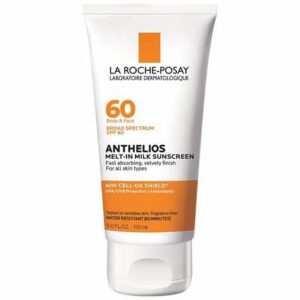
La Roche-Posay Anthelios Melt-in Milk Sunscreen SPF 60 stands out as a trusted and highly regarded sun protection solution. Renowned for its superior broad-spectrum protection against UVA and UVB rays, this sunscreen is celebrated for its lightweight and non-greasy formulation. The “Melt-in Milk” texture effortlessly blends into the skin, leaving a smooth and invisible finish without the sticky residue commonly associated with some sunscreens. This feature makes it an excellent choice for both daily wear and outdoor activities, providing effective sun protection without compromising comfort.
With an SPF rating of 60, La Roche-Posay Anthelios Melt-in Milk Sunscreen offers a high level of protection against the sun’s harmful rays. The brand is often recommended by dermatologists, emphasizing its efficacy and skin-friendly qualities. Additionally, La Roche-Posay is known for incorporating advanced skincare technologies into its products, making this sunscreen suitable for those with sensitive skin. Regular application of this sunscreen ensures a reliable defense against sunburn and premature aging, making it a staple for individuals seeking a reliable and comfortable sun protection solution.
Neutrogena Ultra Sheer Dry-Touch Sunscreen SPF 100+:
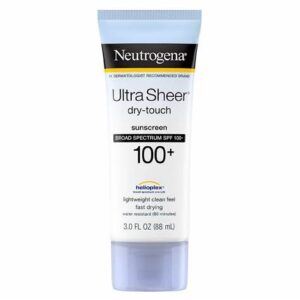
Neutrogena Ultra Sheer Dry-Touch Sunscreen SPF 100+ has earned a reputation as a go-to choice for those seeking high-level sun protection with a lightweight and comfortable feel. With its SPF 100+ rating, this sunscreen offers robust defense against both UVA and UVB rays, making it an ideal choice for individuals with fair or sun-sensitive skin. What sets this product apart is its “Dry-Touch” formula, designed to provide a matte finish without the greasy residue commonly associated with high SPF sunscreens. This feature makes it particularly popular for everyday wear, allowing users to enjoy comprehensive sun protection without the discomfort of a heavy or sticky texture.
The Neutrogena Ultra Sheer Dry-Touch Sunscreen is water-resistant, making it suitable for outdoor activities and water sports. Its oil-free and non-comedogenic properties make it an excellent option for individuals with oily or acne-prone skin, as it won’t clog pores or contribute to breakouts. With its broad availability and positive reviews, Neutrogena’s Ultra Sheer Dry-Touch Sunscreen SPF 100+ continues to be a trusted choice for those seeking a high SPF sunscreen that seamlessly integrates into their daily skincare routine while providing reliable sun protection.
CeraVe Hydrating Mineral Sunscreen SPF 30 and SPF 50:
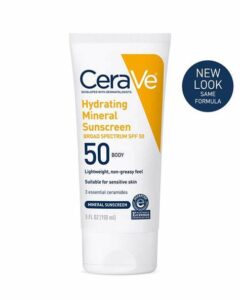
CeraVe Hydrating Mineral Sunscreen in SPF 30 and SPF 50 exemplifies a dermatologist-recommended choice for sun protection, particularly catering to individuals with sensitive skin. What sets this sunscreen apart is its reliance on mineral ingredients, zinc oxide, and titanium dioxide, creating a physical barrier against UVA and UVB rays. The inclusion of ceramides in the formula contributes to the overall hydration of the skin, reinforcing the skin’s natural barrier. This feature is especially beneficial for those with sensitive or easily irritated skin, as the sunscreen not only shields against sun damage but also nourishes and maintains the skin’s moisture balance.
The CeraVe sunscreen’s gentle and non-irritating formulation makes it suitable for daily use, even for those with conditions like rosacea or eczema. With its broad-spectrum protection and added skincare benefits, users can enjoy sun protection without compromising on their skin’s health. The SPF 30 and SPF 50 options allow users to choose the level of protection that aligns with their specific needs, ensuring a versatile and reliable sun care solution for various skin types and lifestyles.
EltaMD UV Clear Broad-Spectrum SPF 46:
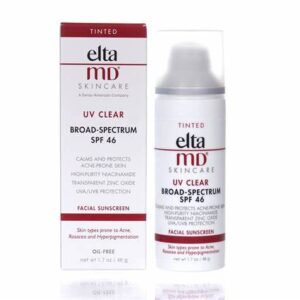
EltaMD UV Clear Broad-Spectrum SPF 46 has garnered widespread acclaim for its dermatologist-recommended formula, making it an exemplary choice for individuals with sensitive or acne-prone skin. This sunscreen combines high-level protection against UVA and UVB rays with a transparent, lightweight, and oil-free composition. Its key ingredient, zinc oxide, acts as a physical barrier, effectively reflecting and scattering harmful UV rays without leaving a white cast on the skin. Additionally, niacinamide, or vitamin B3, is incorporated into the formula, providing antioxidant benefits and promoting a more even skin tone. This makes EltaMD UV Clear not only a reliable sun protection solution but also a skincare treatment that addresses various concerns.
The “Clear” in its name aptly describes the sunscreen’s ability to blend seamlessly into various skin tones without causing irritation or triggering breakouts. EltaMD UV Clear is suitable for daily use, even under makeup, thanks to its sheer and non-comedogenic formulation. Its versatility, coupled with its reputation for being gentle and effective, has made it a staple in many skincare routines, reinforcing the importance of a holistic approach to sun protection that encompasses both health and aesthetics.
Supergoop! Unseen Sunscreen SPF 40:
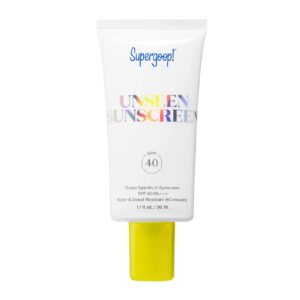
Supergoop! Unseen Sunscreen SPF 40 has emerged as a popular choice in the realm of sun protection, celebrated for its innovative and transparent formula. This sunscreen’s standout feature lies in its clear, weightless, and oil-free composition, which seamlessly blends into all skin tones without leaving a residue. Its unique gel-like consistency is designed to be invisible upon application, making it an excellent option for those who prefer a natural finish without the typical white cast associated with some sunscreens. Beyond its aesthetic appeal, Supergoop! Unseen Sunscreen boasts broad-spectrum protection against UVA and UVB rays, helping to prevent sunburn, premature aging, and reducing the risk of skin cancer.
The versatility of Supergoop! Unseen Sunscreen extends beyond its ability to serve as an effective standalone sun protection product. Its primer-like qualities make it an ideal base for makeup application, creating a smooth canvas for foundation without compromising its efficacy. The inclusion of antioxidant-rich ingredients further enhances its skincare benefits, contributing to an overall protective and nourishing experience. With its combination of functionality, transparency, and skin-friendly attributes, Supergoop! Unseen Sunscreen has become a favorite among those who prioritize both sun safety and a seamless application process.
Conclusion:
Understanding how sunscreen works and the significance of SPF is key to making informed decisions about sun protection. While sunscreen allows you to enjoy the sun responsibly and reduce the risk of sunburn, it’s essential to remember that no sunscreen provides complete immunity from UV radiation. Embrace the sun safely, protect your skin, and achieve that sun-kissed glow responsibly.
